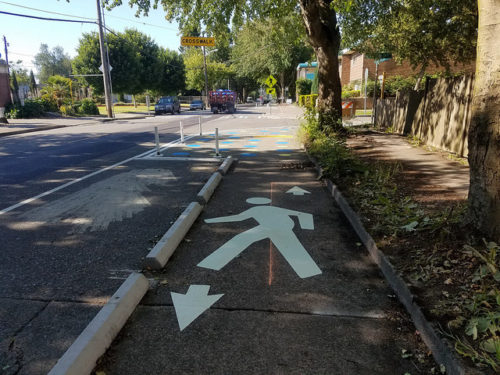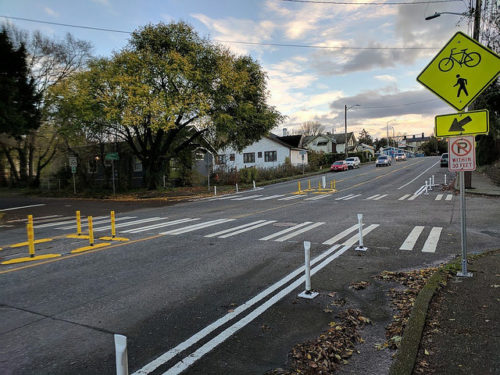Adaptive Mid-Block Treatments
Adaptive treatments may be applied mid-block to reallocate space to pedestrians or bicycles or calm traffic. Mid-block adaptive treatments consist of a clearly defined space delineated by striping and other surface treatments. Additionally, vertical separation must be provided to enhance visibility of the treatment and to restrict motor vehicle access.
These treatments may be initiated by SDOT where there are documented speeding issues, or where pedestrian safety might otherwise be improved by such treatments. Adaptive mid-block treatments may only be installed by SDOT.
Sidewalk Widening

Adaptive sidewalk widening consists of reallocating a portion of the street to an adjacent sidewalk that is too narrow for the volume of pedestrian traffic it needs to accommodate. When extended to the intersection, an adaptive sidewalk widening shortens the crossing distance. The adaptive sidewalk widening should strive to meet the dimension applicable for the street type or meet the minimum ADA width requirement of 4’. The edge must be delineated with a directional tactile indictor to guide visually impaired pedestrians to a safe crossing. The intersections must be marked with tactile domes aligned with the adaptive sidewalk widening.
Mid-Block Medians

Mid-block traffic calming devices such as chokers (also called neckdowns) and chicanes may be installed on an adaptive basis to address a speeding issue and evaluate any effects they may have in terms of traffic diversion. Chokers and/or chicanes should be avoided on neighborhood greenways or streets that have other bicycle facility recommendations. See Traffic Calming for more information on traffic calming.
Adaptive medians may be installed on streets where there is a continuous center turn lane to slow motorists by narrowing the operating space or to restrict left turns and decrease conflict points with pedestrians and bicyclists.
Adaptive Mid-block Treatments Design Guidance
- Adaptive sidewalk surfaces should use epoxied gravel, paint, thermoplastic or other highly durable, contrasting, and slip-resistant surface treatments to delineate pedestrian space.
- Vertical separation/delineation can be achieved with flexible bollards, rubber curbing, parking stops, large planter boxes, concrete/stone barriers, or even art installations. Vertical elements should be a maximum 36 inches in height.
- Mid-block treatments alter existing traffic patterns by decreasing the width or number of motor vehicle lanes. Therefore, consideration should be given to traffic diversion, parking impacts, and other potential impacts prior to implementation to ensure that impacts are balanced with community need.
- If there is an existing crosswalk, it must extend to the existing curb ramp; this may require a break in the painted bulb.
